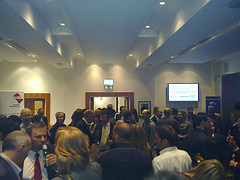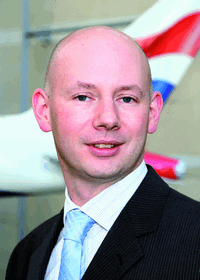MMA Brands and Agencies London event shows the power of mobile
 On Monday 16th in March at London’s BAFTA, I attended an evening run by the UK chapter of the Mobile Marketing Association aimed specifically at Brands and Agencies. It was literally standing room only as the picture on the left shows (see more on my Flickr site) and the evening was sponsored by O2, MIG, MX Telecom, The Guardian and the Marketing Society and everyone agrees that it was a complete success.
On Monday 16th in March at London’s BAFTA, I attended an evening run by the UK chapter of the Mobile Marketing Association aimed specifically at Brands and Agencies. It was literally standing room only as the picture on the left shows (see more on my Flickr site) and the evening was sponsored by O2, MIG, MX Telecom, The Guardian and the Marketing Society and everyone agrees that it was a complete success.
The fact that O2 were one of the sponsors tells you that they are taking mobile advertising seriously.
When I arrived at the event, I ran into the usual suspects and we all commented to each other that we hoped the room was NOT full of “mobile people” – because we are already convinced that having mobile in the marketing mix is the future. MC Paul Berney, who is EMEA MD of the MMA commented that of the 245 people in attendance, 65% were from Brands and Agencies. Indeed there were many new faces at the event (lots of “marketing types”) who were all keen to understand how mobile might fit into their plans. In true MMA form, there was a mobile site developed to promote the event and many people opted in to receive mobile reminders via SMS.
The MMA’s UK networking committee has planned a series of Brand & Agency Briefings throughout this year to provide an opportunity to hear directly from leading brands and agency thinkers on how they are using the mobile channel today and what they plan to do next. For this first session, the presenters were Chris Carmichael from BA.com, Steve Wing from the Guardian, and Rory Sutherland from Ogilvy.
I was madly twittering through the event, as a way to share the excellent content with my followers, but also provide myself with some notes – from which this post has been constructed. If you follow me, you can search through my tweets to grab anything not covered here. Interestingly for such a well attended event, I only saw tweets related to the briefing from @ilicco, @KT_Johnson, and @wbiggs.
 First up – Chris Carmichael from BA.com
First up – Chris Carmichael from BA.com
Chris delivered some interesting stats on the newly launched ba.com for mobile (head to ba.com on your mobile and you get a mobile friendly experience provided by usable.net).
- Most BA.com mobile users are Blackberry or iPhone users (50% have an iPhone)
- The day it snowed in London was the biggest day for mobile traffic to ba.com (people on the way to the airport checking their flight status)
- BA.com mobile users are not just corporates – also families “wanting to sit together” and selecting seats while on holiday via their mobile
- BA see a huge opportunity for research from the mobile, as well as purchase, wayfinding in airports and information on their destination
- BA’s focus area is using mobile to drive sales. Users look up the BA phone number and dial but they don’t transact via the mobile
- Ads on mobiles (driving to BA.com) are not of huge interest to BA at the moment
- BA focus at the moment is mobile internet. Want to make it easy to get a boarding pass for the return journey or change the flight from the meeting that has run over and check in via mobile.
- 45% of customers use online checkin for the outbound journey but not for the return – drive return usage via mobile
- BA exec club members now have dedicated mobile access. Research showed many do not take their booking reference number with them
- There have been 70,000 downloads of the BA mobile iPhone application
- The mobile site has seen 200% month-on-month growth with 95,000 users in February 2009
- As an international brand the need to have a mobile site but need to tune the site for the brand
- Chris compared where they are in terms of a mobile presence as being like 1997 for their web presence
- They are watching closely what is happening with mobile barcodes but have no immediate plans to use them – they feel the technology is not right for them yet
- The mobile channel (and the 70K iPhone users) is also a good marketing research channel – they are focused on building the channel at the moment and have no plans to market directly to these 70K people.
Steve Wing – The Guardian
- The Guardian have taken a while to launch a mobile site – now live m.guardian.co.uk
- Until now guardian did not have digital priority in mobile – mobile had little to offer – the are looking for reach, relevance & revenue (the 3 R’s)
- BUT now the Guardian can get reach and be found on mobile and be relevant. They are seeing millions of iPhone impressions
- They think mobile advertising has some way to go yet to become a commodity
- They believe now that mobile is to compelling to ignore, to disruptive to not take part
- They see mobile as the “beginning of forever”
- The final comment was “digital builds brands, and brands build digital”
 To close the evening, we had the legendary Rory Sutherland from Ogilvy. He delivered a powerful case for why brands should use mobile – and this comes from someone who has been deeply involved in the traditional advertising space and now clearly gets the power of mobile and digital.
To close the evening, we had the legendary Rory Sutherland from Ogilvy. He delivered a powerful case for why brands should use mobile – and this comes from someone who has been deeply involved in the traditional advertising space and now clearly gets the power of mobile and digital.
A summary of his points are below:
- Mobile was initially seen as a portable version of the internet. Rory first used the internet in 1987
- Rory is was converted to mobile when phone screens became better
- He thinks on mobile you need a large enough screen to see 5 options to choose from and not 2
- Taking apps to the front page on iPhone has helped adoption
- Kodak snow insider application from Ogilvy – they expected 10K downloads and experienced 160K
- Key learning is the upside from mobile is big and can’t be ignored
- He sees a shift from entertainment to communication – branded utility for mobile is becoming more interesting (ie not an iPint application – use only once), but a branded apps you would use every day – eg train timetables)
- Useful apps like ba.com will be more successful rather than entertaining. Utility is more important
- Traditional advertising people think you have change what people do to have them consume and purchase – but Rory believes that to change what people do, you have to change what they think… changing behaviour is the best way to change attitude
- Users become impatient on mobile. On the web things just happen. When out and about you just want it to happen now
- A typical 17 year old comment is “the problem with McDonalds is it is too slow – you need to queue” (this is a gen Y view of the world)
- Mobile may be a more important medium than web > you don’t have to get out of chair to use it
- Surveys by the Cancer Council show that young people are more generous when donating by text – if you make it easier the negative perceptions fade away
- One of the key points of Rory’s talk was that the interface determines the audience
- The nature of the interface determines the choice of the interaction
- The interface choice comes first before brand choice eg you will see 14 people in a drive-thru but none inside the McDonalds restaurant – they choose the interface before what they will eat
- Low cost booking online is now seen as an intelligent way of interacting with a brand
- Another great soundbite was “the mobile is the 1st port of call so you have to be there“
- Mobile can be used as a pre-emptive strike with consumers
- Great example of user interaction via mobile http://www.fizzback.com – allows customers to submit feedback on user experience via mobile with a live dashboard for brand owners. This has lead to better and more useful comments
- Twitter is an excellent way to see what people think of your brand – go to search.twitter.com and put your brand name in – what are they saying about you? You can use this as a real time brand monitor for free
- Killer soundbite “comparing twitter to email is like comparing a postcard to a letter“
- Google turned a target audience into a target moment – identify audience at the moment they are interested via the mobile
- Many in marketing are in love with the persuasion model not the behaviour model. We need to make transacting easy in the mode the customer wants
- With mobile – the approach to risk is less of an issue – spend £50K on mobile not the same amount on the TV market research as part of a £3M spend. The research is seen as “loss avoidance”
- The research methodology is very different for mobile, and the potential upside is HUGE
- The strange thing is that inexpensive things eg £50K on mobile vs £3M TV – it seems to be harder to justify a spend like £50K because this is something we can visualise. A £3M spend seems so large it must be right. With mobile £50K is a big spend that will get you a big return
- Rory’s final thought – dandelions – if they die who cares. Try it out – it is not about spending £3M on TV – experiment with mobile NOW
Rory’s talk was timely and had so much useful information. If you are in an agency or a brand, please consider printing out this post and going through it again. If you follow just one piece of Rory’s advice here you will already be in front of your competitors when it comes mobile.
Let’s face it – we all have a mobile – with us right now so let’s use this as a channel as well. Mobile is not hard, it’s just people perceive it is hard because it is a new medium.
Next of course is execution! Feel free to contact me and I can speak to you about how mobile can provide an immediate uplift for your brand – and get you started on mobile now.
The MMA have scheduled the next Brands and Agencies event for Thursday June 4th in London – mark your diaries now. We will need a bigger venue next time. See more pictures of the event on Flickr.